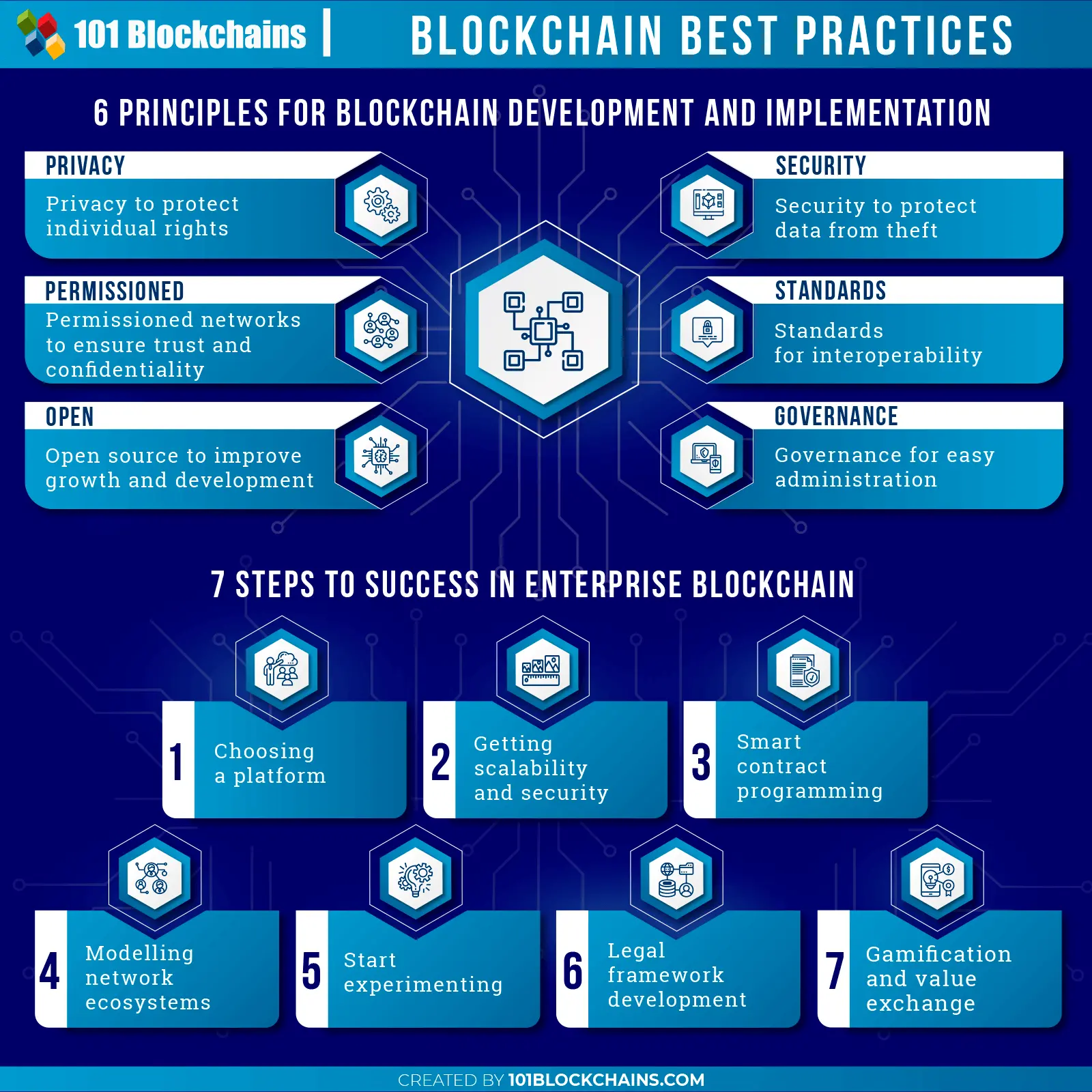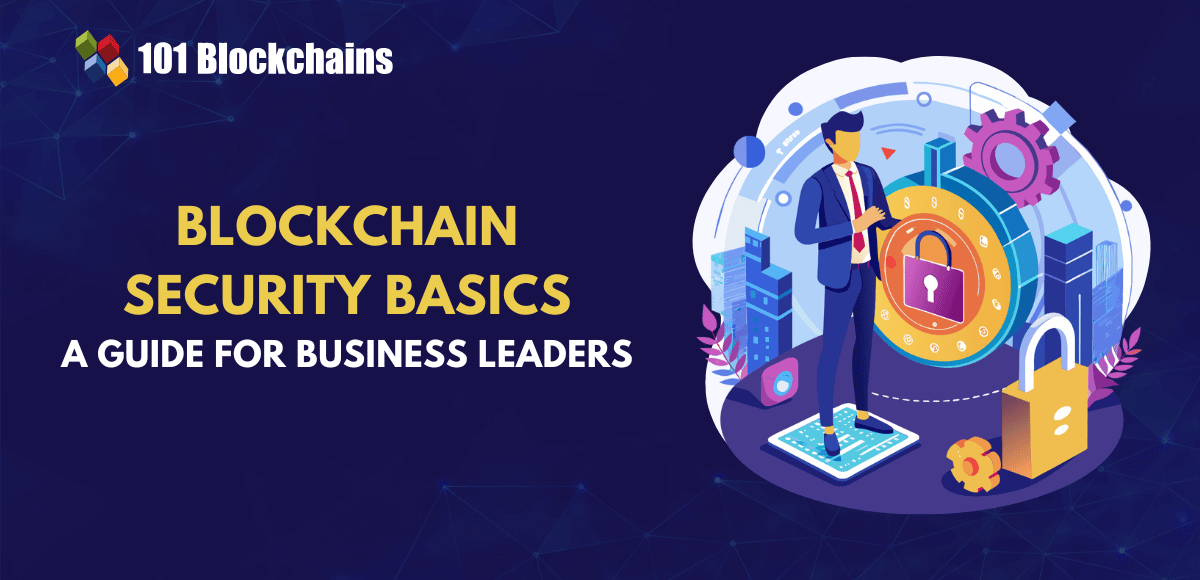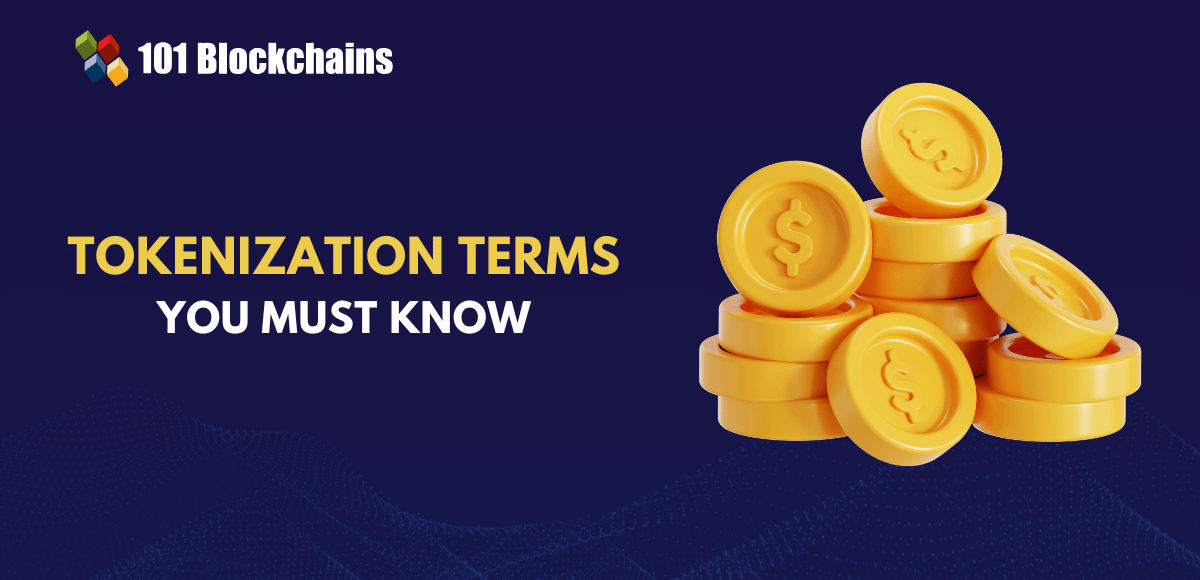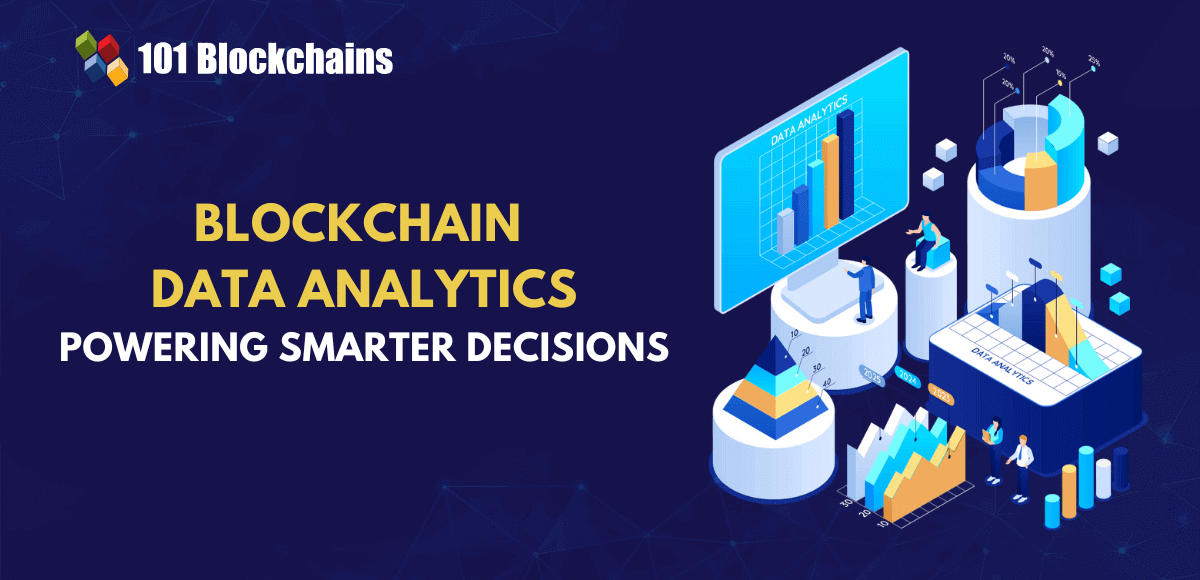Learn how blockchain truly works, master key definitions, and uncover what makes smart contracts so "smart." Dive into the fundamentals, gain valuable insights, and start your blockchain journey today!
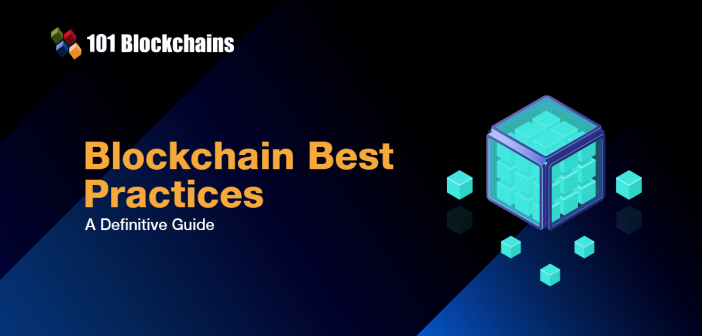
- Blockchain
101 Blockchains
- on August 08, 2021
Blockchain Best Practices – Enterprise Blockchains Principles
Distributed ledger technology(DLT) provides a clear business advantage. This means that early adopters can take advantage of it.
Do you want to adopt blockchain in your business process too? If you do, then you need to follow blockchain best practices. These best practices will help you to explore blockchain in the right way. By using technology, you can strengthen your platform and make it aligned with the current trends.
Build your identity as a certified blockchain expert with 101 Blockchains’ Blockchain Certifications designed to provide enhanced career prospects.
Best Blockchain practices
Before we go deep into the best practices, let’s learn what key ingredients are needed for a blockchain to be useful in an enterprise environment.
The blockchain ecosystem is evolving, and there are best practices for everyone out there. If you are a blockchain architect, then you have to follow best practices for a blockchain database engineer. In the end, it is the best practices that make your work shine.
To make things simple, we will start with the six principles of blockchain implementation and development. This will establish the core of our discussion and best practices.
Please include attribution to 101blockchains.com with this graphic. <a href='https://101blockchains.com/blockchain-infographics/'> <img src='https://101blockchains.com/wp-content/uploads/2019/08/blockchain-best-practices.png' alt='blockchain best practices='0' /> </a>
With enterprise blockchain in mind, we will then move to discuss the steps required to build a blockchain solution or service.
What are we going to cover?
Blockchain practices can differ depending on what you are doing. If you are an enterprise, then you might have to follow enterprise-related practices. If you are a blockchain architect, then there is a different practice that you need to follow. To help you, let’s go through the structure of the article.
Blockchain For Enterprise: Principles, Steps, And Best Practices
Six principles for blockchain development and implementation
-
Open
The blockchain solution should be open. This means that it should be open source allowing anyone to contribute to its growth. The open-source tag will also bring innovation and ensure that quality code is maintained.
-
Permissioned
Permissioning is also a critical principle that an enterprise blockchain needs to follow. Permissioned networks are designed to work in a closed ecosystem by keeping key features of blockchain intact. It promotes confidentiality and trust and ensures that illegal activities can be controlled. Permissioned networks also ensure that only trusted entities can interact with the network — making it more secure and viable in the long run.
-
Governance
Enterprise blockchain should have proper governance system. It enables administrators to run and maintain the network. Strong governance ensures that no one can abuse the network for their advantage. Admins can take necessary steps to stop malicious actors before they start to attack the network or stop them during the attack.
-
Security
Security needs to be top-notch for any blockchain development. Blockchains are secure, but they still require proper security planning and execution. Also, it is an on-going process, and the security team should do a periodic check to ensure platform integrity.
-
Standards
Standards are also a key part of any blockchain solution. With interoperable standards, it is easy for teams to work across different requirements, needs, or integrations. Right now, there are only independent entities that are working on their own blockchain solution — which is not a good idea for the long run.
-
Privacy
The privacy aspect is also very important. Without the right to privacy, a blockchain solution cannot do justice to its other features such as transparency or immutability. That’s why an enterprise blockchain solution should work towards a solution that offers privacy from the onset.
Start your blockchain journey Now with the Enterprise Blockchains Fundamentals
Blockchain Best Practices: Seven Steps to Success in enterprise blockchain
Now, that we understand the core principles of an enterprise blockchain. Let’s go through the seven steps to success in enterprise blockchain.
1. Choosing a platform
The first step is to select a platform. Building your platform can be a viable option, but it requires a substantial monetary investment. It is not feasible for most businesses out there. That’s where the existing platforms come in.
Before you proceed, you need to understand that there are trade-offs on existing platforms. They are not perfect and are not entirely aligned with your requirements. Also, not all platforms serve equal value or features. Some might be great at governance, whereas others would be great for scalability.
Current generation platforms such as Hyperledger offer a lot of options. You can use other enterprise platforms such as IBM Blockchain, SAP blockchain, and others.
In short, you need to understand that each platform has its limitations and you have to decide beforehand which one you want to choose.
Want to know everything about Hyperledger Fabric? Enroll now in Getting Started with Hyperledger Fabric Course
2. Start experimenting
As an organization, you need to start experimenting with blockchain. Which aspects of your organization can be transformed using blockchain? Is it the supply chain or the administration? Figuring out these things and experimenting on a low scale can let you know the exact results.
With marketing evolving rapidly, it is up to you to test out new trends. Early adoption is always useful as it gives you an edge. However, it is also risky. Also, starting early has its own advantage. It will let you build an informal relationship early and also develop an understanding of the technology. You will also be able to lure better talent. In short, you will be agile and ready to take advantage of new technology.
Excited to learn about the supply chain in blockchain? Enroll now in Enterprise Blockchains and Supply Chain Management Course
3. Get scalability and security right
There is no doubt that blockchain is secure. But, that doesn’t mean that you do not have to pursue the security of your blockchain actively. Permissioned approach is used to ensure that only authorized people can access the network. This centralized model protects the blockchain network from many threats, including 51% attacks.
Centralized networks are also good at scaling. It can reach 2000TPS, which is excellent, considering that there will be limited nodes that are going to take part in the network.
So, as a business, you need to make sure to get scalability and security right. You can read more about enterprise blockchain security here.
4. Building a legal framework
The next step is to get the legal work done. As blockchain is decentralized, it is hard to control or legalize the network. But a small step towards legalization can protect your network from any bad engagement, and ensure that everyone works to their best possible intentions.
5. Getting smart contracts ready
Smart contracts are a big part of any network. It acts as a mediator that takes care of everything between two parties. It only gets executed if a certain requirement is met. This is very useful for automating a lot of blockchain tasks.
You should also use smart contracts to enforce rules so that no is able to break them.
Curious to understand the complete smart contract development lifecycle? Enroll in Smart Contracts Development Course Now!
6. Gamification and value exchange
Creating a marketplace on your blockchain will let you make it popular among the users. That’s where gamification comes in. You should also focus on value exchange models, which let you take advantage of non-monetary, monetary, and consensus methods.
7. Modeling network ecosystems
The last step is to get your blockchain business model aligned with the economic models out there. This will help you figure out how engagement will work in your system. Clearly, there are plenty of ways you can do it, but tinkering is what you need to do.
Not sure how to build your career in enterprise blockchains? Enroll Now in How to Build Your Career in Enterprise Blockchains
Best Blockchain Practice for Enterprise
Awesome! Now that we have gone through steps to success in enterprise blockchain and risk management, it is now time to share the best practices for enterprise blockchain.
These best practices are shared by the Hyperledger, one of the leading blockchain enterprise solutions out there. These best practices for blockchain is also applicable to different types of businesses and their use of blockchain platform. It will help any business to cope directly with security, data, and business process.
1. Securing a business process is an on-going process
Blockchain is defined as a peer-to-peer network which is touted to be super secure using cryptographic algorithms. The definition is correct, but that doesn’t mean that it is secure all-the-time.
As a business, you need to make sure that you do not think on the same line. This assumption that blockchain is already secure can cost your business heavily. There are many ways a blockchain network can be hacked. Bad actors can play a crucial role in making the network fail. They can also succeed in breaking the cryptographic algorithm in the future.
You should always work to secure your blockchain solution now and in the future. Not only that, in the future, we will have quantum computing, which is capable of breaking the current cryptographic algorithms.
If it is secure today, then you have to make sure it is secure tomorrow as well. That’s why it is always a good idea to keep a tab on new techniques that makes your blockchain more secure. Security is a process rather than a one-time task.
2. Use permissioned blockchain for private data
Using permissioned blockchain is important to make your data secure. The enterprise generates tons of data, and not all data is meant for the public. That’s where permissioned network comes in.
Before you commit, you need to identify the right blockchain for you. As an enterprise, you should always avoid public blockchain solutions. With permissioned blockchain, data can be stored or accessed within a secure network. They can decide who participate in the network which simplifies data security to a large margin.
There are many permissioned networks, including Hyperledger, SAP blockchain, that lets you do that. Public blockchains such as Ethereum and Bitcoin should be avoided.
Permissioned blockchains are also known as a consortium or private blockchains. But they both fall under the permissioned blockchain category.
3. Creating a governance structure for blockchain
Even though blockchain is technically hard to implement at an enterprise level, it is the governance aspect that is more challenging. As an enterprise, you need to ensure that you choose the right governance model.
Initially, it is a good idea to define the governance structure upfront. Once done, you can dive into blockchain implementation. The governance model should contain a plethora of things, including how new users are added, the role of existing roles, different tiers of users and their respective role, data storage mechanism, and so on.
The governance model should also work proactively to remove bad actors from the network. Not only that, but it should also handle other situations, both critical and non-critical.
One more thing that needs to be taken care of is governance procedure change over time. It is not a good idea to stay fixed to one version of the governance model. Things evolve, and so does the governance model. It is better to develop proactively.
Curious to learn about blockchain implementation and strategy for managing your blockchain projects? Enroll Now in Blockchain Technology – Implementation And Strategy Course!
4. Understand and analyze blockchain cases early
Business is complex and requires proper understanding and execution. The same applies to blockchain. It is the latest technology that is evolving at a rapid pace. To understand the complexity and ensure that you can implement it successfully, you need to go through the blockchain use-cases.
The blockchain use-cases analysis needs to be done at an early stage. It will help enterprises to design and strategize accordingly. It will also let you define goals.
There are plenty of use-cases out there. Your job is to ensure that you go through the use-cases in your sectors such as health, supply chain, or finance, and learn from there. In the end, you will be able to capture the strengths of these use-cases and implement them in your enterprise blockchain implementation.
5. Decide scalability and performance requirements
There are many ways a blockchain can be implemented. This also means that there are different types of challenges that a blockchain architect has to go through. In the process, the blockchain architect needs to make some comprises. It can be scalability or performance issues.
To ensure that you do not have to compromise early, it is a good idea to decide upon the scalability and performance requirements early. Also, these decisions need to be made early so that blockchain implementation doesn’t get hampered. Enterprises can also develop different blockchain, each for their specific requirements, including performance, scalability, or governance.
6. Never store large files on the blockchain
As we already discussed blockchain is a peer-to-peer network. It replicates data across the network. The replication process can take some time.
As a blockchain architect, you need to set a file limit on the blockchain. That means storing large files is not an option. If it is done, then both the compute and storage costs will go away.
By maintaining this, costs can be saved. If there is a need to store large files, then you need to use cloud services to store files and use pointers in the blockchain to point to the actual file.
Best Practices for Database Engineer and Blockchain Architect
Now, that we have understood the best practices related to enterprise development, let’s go into the best practices for a blockchain architect. We will start with the database and then move on to more general practices regarding blockchain development.
Best Practices: Managing Blockchain Databases on Cloud Platforms
Databases are a critical part of a blockchain. They define how data is stored and retrieved. As a blockchain architect or a database engineer trying to develop their blockchain solution on cloud platforms, it is essential to follow blockchain best practices to ensure proper database management.
Let’s go through the best practices that you need to know to manage the blockchain database on cloud platforms.
1. Understand blockchain properly
Before you start managing the blockchain database, you need to get a proper understanding of blockchain itself. Most of the time, it is the improper understanding of blockchain that affects blockchain development.
Blockchain’s idea is simple. As a blockchain architect, you should understand that it is customizable. It also has tons of use-cases and is not limited to only cryptocurrencies. Also, it utilizes peers to store and manage the network. Without the peers’ contribution, a blockchain cannot exist. It is the peers even who save a copy of the data.
To give you a better perspective, you can think blockchain as a better cloud solution. It provides a better way of handling data and keeps them secure. Also, as it is decentralized, it is not possible to do any manipulation — which is entirely possible in a centralized environment.
2. Blockchain is not the ultimate solution for security
We already discussed the security point above, and it is also applicable to the data handling in the blockchain. Even though blockchain is touted as the most secure technology out there, it is not 100% secure. There are many ways hackers or third party malicious actors can take over the blockchain, manipulating data and destroying the very essence of a blockchain network.
As a blockchain architect, you need to be cautious in your approach and ensure that you protect the blockchain with proper implementation of governance rules. You should also ensure that personal data is made secure in the best possible way.
In short, you need to take all the necessary steps to make sure that the data remains secure. Blockchain is not the one-stop security solution.
3. Use tools that you are familiar with
Blockchain is a new technology. This also means that you will be able to find a plethora of tools to work with it. Almost every business out there is trying to make their own blockchain solution and toolset.
To make sure that you do your best, you need to stick with the best tools out there. By choosing the already established solutions to manage your blockchain, you can ensure that your project is on-time and can be managed in the future without much difficulty.
For example, you can take advantage of Microsoft’s Azure Blockchain. They offer a development kit that lets you work effectively with Azure services. Also, the tools might not be useful to you as you may have a different requirement. In that case, you should pick the tools that fit your requirements well.
Want to know more about Blockchain tools and templates? Enroll in Enterprise Blockchains Templates course now!
4. Use easily verifiable data
Last, but not least, you should focus on easily verifiable data. Blockchain relies heavily on peers to handle data by replicating them. Take cryptocurrency, for example, — they work in real-world because they use numerical data which can easily be tracked or referenced.
That might not be the case for businesses out there. They have to use a complex form of data which can be composed of integers, strings, and other data forms. Your job as a blockchain architect is to ensure that you can convert the complex data into verifiable data. You can also use cloud storage and references to the storage to store complex data. The easily verifiable data will also help you to make your data more secure.
Best practices for a Blockchain Architect
In the last section, we will cover the best practices for a blockchain architect. There are many roles and responsibilities for a blockchain architect. They need to take care of the whole end-to-end solution. This means developing proper blockchain ecosystem engagement strategy, create performance metrics, generate risk/failure analysis, follow best blockchain practices, and create them as well. Lastly, they need to monitor and train technical staff. That’s a lot of work.
One of the most significant responsibilities for a blockchain architect is to follow best practices. We have listed five best blockchain practices for you to follow. Let’s list them below.
1. Profound knowledge of underlying technology
If you are working as a blockchain architect, you need to make sure that you understand the DLT technology completely. To do so, you should build a modular blockchain that offers customizability and operability. To maximize your learning and knowledge, you should also try to create a two-part design. The two-part design will contain a blockchain network and distributed storage. In the end, the solution should be able to easy to use for the enterprise. Moreover, you should know how to handle sensitive information and keep them safe.
2. Open Governance
Open Governance is the best way to go. It provides enterprise using the blockchain to tune it later on. As a blockchain architect, you need to understand the importance of open Governance and drive better results for your company. To get started, you need to ensure a codebase that is properly understood by other developers. This means that it will be easy to manage. It will also bring more transparency to the system.
3. Wide range of developer tools
The tools and techniques are an important part of a blockchain solution. To make sure that the company can take full advantage, you need to use the right tool. It will help accelerate the implementation and adoption process of the blockchain.
4. Skilled in building permissioned ledgers
If you want to be an effective blockchain architect, you need to have the ability to build permissioned ledgers. There are many popular permissioned ledgers out there. Also, not all blockchain solution provides a permissioned solution from the onset. However, you need to modify it so that it works as permissioned and brings the key features into play. There are many benefits of permissioned nodes, including speed, security, efficiency, immutability, and so on.
5. Scalability
Lastly, you need to make sure that you can scale your blockchain solution. You can use IPFS systems which are good for scalability.
Blockchain Best Practices: Testing Blockchain and Risk Mitigation
Just like any other application, blockchain also needs to be tested before it can go live. As blockchain technology help build trust, you also need to make sure that the blockchain solutions stands true to its core values.
As a tester, you need to start small and test your application. In short, you need to take care of two types of testing.
1. API testing
In API testing, you need to take care of the interactions that your applications make with other elements in the blockchain ecosystem. It is widespread for a blockchain to interact with other elements. For example, it can emit events, do external calls, or trigger an event when some condition is met. This can be used in many ways. A supply chain can gather information from the external server and order a new batch if there is a need or the conditions are matched. The best practice to do testing is to validate all the interactions with other services or solutions. Go through each API request and ensure if they are working as intended or not.
2. Functional testing
Functional testing is another part of testing where you check the different blockchain components. It also covers the whole platform, as well. As a blockchain tester, you need to do use-case based testing while ensuring that the block and chain size expectations are met. You may also want to test block addition as well.
3. Performance testing
Lastly, you also need to do performance testing. Performance testing ensures that the user doesn’t have to wait for a long time for a transaction to be completed. Other vital aspects that need to be tested for performance include smart contract response time, system interface response time, and so on. You should also find out the bottlenecks and try to eliminate them. In the end, you should tune the system so that it performs at its best.
Performance tests should also be done at multiple endpoints and cover all the different aspects of blockchain.
4. Blockchain and Risk Mitigation
Blockchain will change how the market works. It has the most impact on the finance sector. This also means that it can act as risk mitigation for the current systems. The current processes are not entirely secure, and that’s where blockchain comes in.
As a blockchain practitioner, you should always try to mitigate risk by using blockchain. Even Deloitte thinks that blockchain is a fundamental technology which will improve risk management in the future.
Each type of blockchain has its risks. Smart contracts are used to embed business logic. They are also self-executing so that most of the business process can be automated.
In short, blockchain should improve risk management techniques. But it is up to blockchain implementers to follow best practices when it comes to risk management.
Start learning Blockchain with World’s first Blockchain Career Paths with quality resources tailored by industry experts Now!
Conclusion
This leads us to the end of blockchain best practices. These best practices for blockchain will help you to handle your blockchain project better. We covered different perspectives, including enterprise, database, testing, and so on.
*Disclaimer: The article should not be taken as, and is not intended to provide any investment advice. Claims made in this article do not constitute investment advice and should not be taken as such. 101 Blockchains shall not be responsible for any loss sustained by any person who relies on this article. Do your own research!

